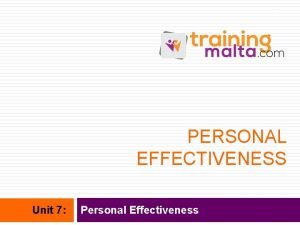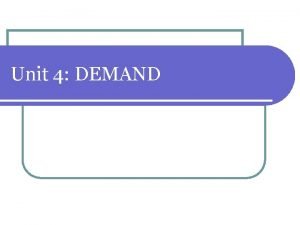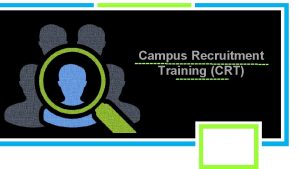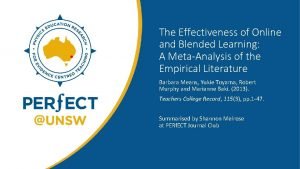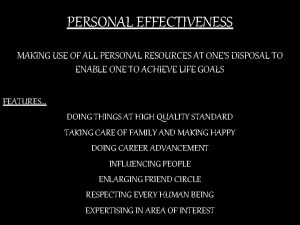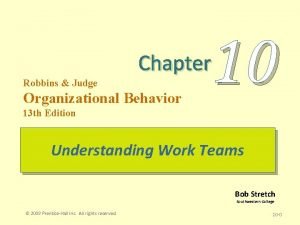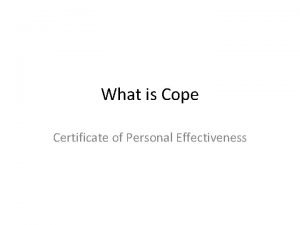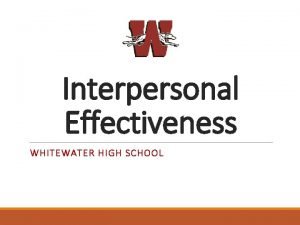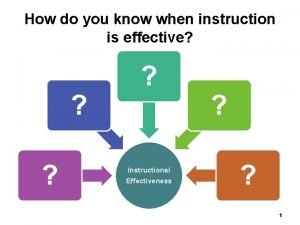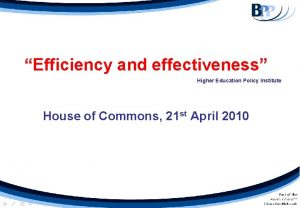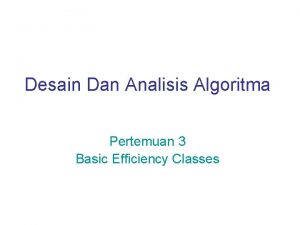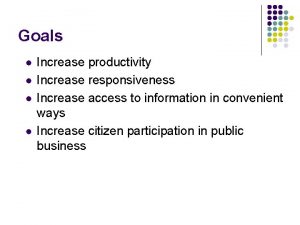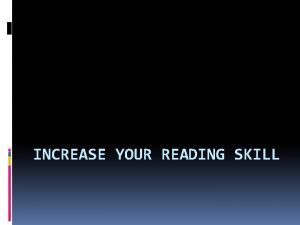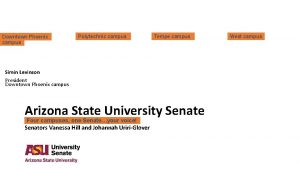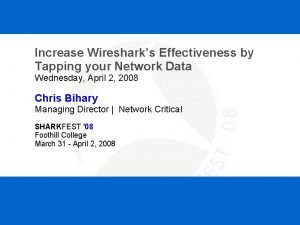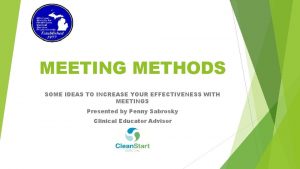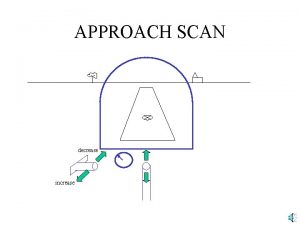Training to Increase the Effectiveness of Your Campus



































































- Slides: 67

Training to Increase the Effectiveness of Your Campus Data Warehouse Maddy Tuinstra Technical Trainer and Consultant Division of Information Technology University of Wisconsin - Madison

© Copyright Madaline Tuinstra 2003. This work is the intellectual property of the author. Permission is granted for this material to be shared for non-commercial, educational purposes, provided that this copyright statement appears on the reproduced materials and notice is given that the copying is by permission of the author. To disseminate otherwise or to republish requires written permission from the author.

“In my twenty years of service for the University, this was the best use of my time spent away from the office. ” -UW Data Warehouse User

Agenda Project Background Goals of Training Steps for Developing Training Obstacles Encountered Evaluating the Training Program

Background UW-Madison

Background UW-Madison Enrollment - Fall 2002: 41, 507 Budget - $1. 6 Billion Faculty / Staff – 2, 213 / 12, 624 Land acres - 10, 649 Annual degrees granted – 8, 900 Undergraduate cost of attendance - Resident $12, 649 (Tuition/fees: $ 4, 089) - Non-Resident $24, 709 (Tuition/fees: $15, 976)

Background Do. IT (Division of Information Technology)

Background Data Access Tools Query Writing Tool - Brio UW-Madison Query Library -A collection of pre-defined queries designed to meet identified campus needs

Background Why were the Data Access tools not widely used? No Incentive Service Fee Data Authorization Software Installation Query Writing Understanding the Data

Background Relative Size of Obstacles No Incentive Access Fee Data Authorization Software Installation Query Writing Understanding the Data

Background Removing the Obstacles No Incentive Access Fee Data Authorization Software Installation Query Writing Understanding the Data

Background Removing the Obstacles No Incentive Access Fee Data Authorization Software Installation Query Writing Understanding the Data No paper reports + 2 years of denial

Background Removing the Obstacles Access Fee Data Authorization Software Installation Query Writing Understanding the Data

Background Removing the Obstacles Access Fee Data Authorization Software Installation Query Writing Understanding the Data Gone as of July 1, 2002

Background Removing the Obstacles Data Authorization Software Installation Query Writing Understanding the Data

Background Removing the Obstacles Data Authorization Software Installation Query Writing Understanding the Data Run Queries from the Library

Background Removing the Obstacles Data Authorization Software Installation Understanding the Data

Background Removing the Obstacles Data Authorization Software Installation Understanding the Data Training

Background Removing the Obstacles Data Authorization Software Installation Understanding the Data Training

Background Removing the Obstacles Data Authorization Software Installation Understanding the Data Training

Background Goals of Training Clarify the data access process Assist users in understanding the data Provide users with clear step-by-step instructions Ultimately get a larger portion of campus to use the Query Library successfully Save money by saving time, gaining efficiency, creating opportunities, and developing inhouse resources

Background 3 Query Library Classes are Born! Introduction to the Query Library (3/28/02) A Closer Look at Student Records Queries (5/20/02) A Closer Look at Enrollment Queries (10/28/02)

Background Class Details We offered 31 classes - 18 Intro, 10 Student Records, 3 Enrollment 305 UW employees attended - Average size class ~ 10 Classes were taught in Computer Labs with Instructor’s computer and projector in front Class lengths ranged from 2 ½ to 3 hours

Steps for Developing Training 1. 2. 3. 4. 5. 6. 7. 8. Identify participant’s knowledge base Identify all parties involved Define unknown or ambiguous terms Describe the “big picture” Define the data elements Create practical, real, hands-on examples Define and document step-by-step procedures Develop an effective presentation

#1 - Identify the Participant’s Knowledge Base Tailor your class to your audience and ensure no one is left out

#1 - Identify the Participant’s Knowledge Base (continued) Participant Feedback Regarding Step #1 -“I wasn't even aware of the query library - good to know. ” -“I appreciate that the instructor realized that I was inexperienced and didn't go too quickly. ” -“I was glad this was truly an Intro course. I had no prior experience and now feel I have learned a great deal. ”

#1 - Identify the Participant’s Knowledge Base (continued) Participant. Feedback. Regarding. Step#1 #1 Participant All participants were asked “Was the Course Level Appropriate? ” -275 responded “Yes. ” -275 “No. ” responded “Yes. ” -30 responded “No. ”

#2 – Identify All Parties Involved Examples include: - Technologists - End Users - Data Experts • Registrar’s Office • Enrollment Office - End User Support Team - Web Support

#3 - Define Terms that May be Unknown to the Typical End-User UW-Madison Examples Include: - Info. Access - Brio - Oracle - Data Warehouse - Query - Dataviews

#4 – Describe the Big Picture Identify the hardware and software involved and how they work together

UW-Madison Query Library Catalog End User Committee Query Campus Network Web Browser (Internet Explorer or Netscape) Query Tool Query (Brio. Insight 6. 6) Your Computer Data Warehouse Financial Human Resource Student

#5 - Define the Data Elements

#6 - Create Practical, Real, Hands-On Examples I will be awarding a scholarship to three students in Chemistry with the highest GPAs, who are these students? What is the percentage of Hispanic students in Theatre and Drama? What are the e-mail addresses of the students I advise?

#6 - Create Practical, Real, Hands-On Examples (continued) Who are the students that are enrolled in any Anthropology class this Fall? Are my classes filling up? Should I ask for a new section? What departments are students enrolling under for a cross listed class?

#7 - Define and Document Step-by-Step Procedures Create a manual - Include screen shots - Clearly list steps - Group information in “chunks”

#8 - Develop an Effective Presentation Include diagrams for visual learners Keep a good balance between lecture, discussion and hands-on activities

Obstacles Encountered Balance between technologically disinclined vs. technologically inclined Time limits Changing technologies Future classes?

Success? Evaluated according to Dr. Donald Kirkpatrick’s “Four Evaluation Levels”: - Reaction - Learning - Behavior - Results

Success - Reaction - How do participants feel about the program? (Customer Satisfaction) 1=poor and 5=excellent -Overall rating of the course – 4. 7 -Usefulness of course content – 4. 5 -Instructor’s knowledge of material – 4. 9 -Instructor’s presentation – 4. 8 -Usefulness of course materials – 4. 7

Success - Learning - To what extent did the participants increase knowledge, improve skills, and/or change attitudes? - “Fine tuned some questions I had. Excellent course for beginners. ” - “I had a few things I didn’t understand the instructor totally cleared it up. ” - “I got farther than I expected, sooner than expected. ”

Success – Learning (continued) Were the Learning goals met? - Clarify the data access process a - Assist users in understanding the data - Provide users with clear step-by-step instructions a a

Success – Behavior - To what extent did their job behavior change? -“The handout will be helpful to take back to office. ” -“This class highlighted things I will actually use, real situations. ” -“I appreciated the chance to use queries to look at our own departments. ” -“This class was easy to follow so I can get going. ”

Success – Behavior (continued) Behavior - To what extent did their job behavior change? Goal: Ultimately get a larger portion of campus to use the Query Library successfully Did we accomplish this goal?

Success – Behavior (continued)

Success – Behavior (continued)

Success – Behavior (continued)

Success – Behavior (continued)

Success – Behavior (continued)

Success – Behavior (continued)

Success – Behavior (continued)

Success – Behavior (continued)

Success – Behavior (continued)

Success - Results - What final results occurred? (Quantity, quality, safety, sales, costs, profits, ROI) We offered 31 classes -18 Intro, 10 Student Records, 3 Enrollment 305 UW employees have attended -Average size class ~ 10

Success - Results (continued) Cost to Offer a Query Library Class: * * This cost was covered by the Office of Quality Improvement

Success - Results (continued) Cost to develop the Intro Query Library Class: * * This cost was covered by the Office of Quality Improvement

Success - Results (continued) $2387. 00 Total Development Cost = / Number 18 of Intro Classes $133. 00

Success - Results (continued) $2387. 00 Total Development Cost = / Number 18 of Intro Classes $133. 00

Success - Results (continued) $2387. 00 Total Development Cost = / Number 18 of Intro Classes $133. 00 + $796. 00 $133. 00 Price to Offer One Class $929. 00 10 participants $93 per participant

Success - Results (continued) Price of the Data Warehouse: ~ $8. 5 million

Success - Results (continued) ROI Goal Met? - Save money by: • Saving Time • Gaining Efficiency • Creating Opportunities • Developing In-House Resources

Success - Results (continued) ROI Goal Met? - Save money by: • Saving Time Quicker to train staff then for them to figure out on own • Gaining Efficiency • Creating Opportunities • Developing In-House Resources

Success - Results (continued) ROI Goal Met? - Save money by: • Saving Time • Gaining Efficiency What if all 160 Departments wrote the same query? • Creating Opportunities • Developing In-House Resources

Success - Results (continued) ROI Goal Met? - Save money by: • Saving Time • Gaining Efficiency • Creating Opportunities Without training some staff would not take the time to learn, leading to missed opportunities • Developing In-House Resources

Success - Results (continued) ROI Goal Met? - Save money by: • Saving Time • Gaining Efficiency • Creating Opportunities • Developing In-House Resources Creating 305 in-house “support staff”

Questions? ? ? ?

THANK YOU!

UW-Madison Query Library Catalog End User Committee Query Campus Network Web Browser (Internet Explorer or Netscape) Query Tool Query (Brio. Insight 6. 6) Your Computer Data Warehouse Financial Human Resource Student
 Personal effectiveness meaning
Personal effectiveness meaning If you keep buying despite a price increase, your demand is
If you keep buying despite a price increase, your demand is Dominican university campus safety
Dominican university campus safety Crt aptitude
Crt aptitude Give us your hungry your tired your poor
Give us your hungry your tired your poor Hình ảnh bộ gõ cơ thể búng tay
Hình ảnh bộ gõ cơ thể búng tay Slidetodoc
Slidetodoc Bổ thể
Bổ thể Tỉ lệ cơ thể trẻ em
Tỉ lệ cơ thể trẻ em Voi kéo gỗ như thế nào
Voi kéo gỗ như thế nào Chụp tư thế worms-breton
Chụp tư thế worms-breton Chúa sống lại
Chúa sống lại Môn thể thao bắt đầu bằng chữ đua
Môn thể thao bắt đầu bằng chữ đua Thế nào là hệ số cao nhất
Thế nào là hệ số cao nhất Các châu lục và đại dương trên thế giới
Các châu lục và đại dương trên thế giới Cong thức tính động năng
Cong thức tính động năng Trời xanh đây là của chúng ta thể thơ
Trời xanh đây là của chúng ta thể thơ Cách giải mật thư tọa độ
Cách giải mật thư tọa độ Làm thế nào để 102-1=99
Làm thế nào để 102-1=99 Phản ứng thế ankan
Phản ứng thế ankan Các châu lục và đại dương trên thế giới
Các châu lục và đại dương trên thế giới Thể thơ truyền thống
Thể thơ truyền thống Quá trình desamine hóa có thể tạo ra
Quá trình desamine hóa có thể tạo ra Một số thể thơ truyền thống
Một số thể thơ truyền thống Cái miệng nó xinh thế chỉ nói điều hay thôi
Cái miệng nó xinh thế chỉ nói điều hay thôi Vẽ hình chiếu vuông góc của vật thể sau
Vẽ hình chiếu vuông góc của vật thể sau Biện pháp chống mỏi cơ
Biện pháp chống mỏi cơ đặc điểm cơ thể của người tối cổ
đặc điểm cơ thể của người tối cổ Thế nào là giọng cùng tên
Thế nào là giọng cùng tên Vẽ hình chiếu đứng bằng cạnh của vật thể
Vẽ hình chiếu đứng bằng cạnh của vật thể Vẽ hình chiếu vuông góc của vật thể sau
Vẽ hình chiếu vuông góc của vật thể sau Thẻ vin
Thẻ vin đại từ thay thế
đại từ thay thế điện thế nghỉ
điện thế nghỉ Tư thế ngồi viết
Tư thế ngồi viết Diễn thế sinh thái là
Diễn thế sinh thái là Các loại đột biến cấu trúc nhiễm sắc thể
Các loại đột biến cấu trúc nhiễm sắc thể Số nguyên là gì
Số nguyên là gì Tư thế ngồi viết
Tư thế ngồi viết Lời thề hippocrates
Lời thề hippocrates Thiếu nhi thế giới liên hoan
Thiếu nhi thế giới liên hoan ưu thế lai là gì
ưu thế lai là gì Hươu thường đẻ mỗi lứa mấy con
Hươu thường đẻ mỗi lứa mấy con Sự nuôi và dạy con của hổ
Sự nuôi và dạy con của hổ Sơ đồ cơ thể người
Sơ đồ cơ thể người Từ ngữ thể hiện lòng nhân hậu
Từ ngữ thể hiện lòng nhân hậu Thế nào là mạng điện lắp đặt kiểu nổi
Thế nào là mạng điện lắp đặt kiểu nổi Criminology unit 4
Criminology unit 4 The effectiveness of online and blended learning
The effectiveness of online and blended learning Steiner model of group effectiveness
Steiner model of group effectiveness Personal effectiveness components
Personal effectiveness components Ntu in heat exchanger
Ntu in heat exchanger Arrangement of people in an organization
Arrangement of people in an organization Efficiency and effectiveness examples
Efficiency and effectiveness examples Cath lab cost effectiveness
Cath lab cost effectiveness How successful were the liberal reforms essay
How successful were the liberal reforms essay Volumetric efficiency formula
Volumetric efficiency formula Cooling equipment heat exchanger
Cooling equipment heat exchanger Enhancing personal effectiveness
Enhancing personal effectiveness Slip slop slap effectiveness
Slip slop slap effectiveness Robbins team effectiveness model
Robbins team effectiveness model Certificate of personal effectiveness
Certificate of personal effectiveness As9100 pear examples
As9100 pear examples Joinmyquiz.comm
Joinmyquiz.comm Instructional effectiveness
Instructional effectiveness Efficiency and effectiveness in higher education
Efficiency and effectiveness in higher education Effectiveness algoritma
Effectiveness algoritma Strategic profitability analysis
Strategic profitability analysis
